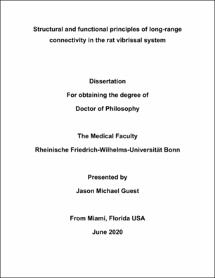Guest, Jason Michael: Structural and functional principles of long-range connectivity in the rat vibrissal system. - Bonn, 2020. - Dissertation, Rheinische Friedrich-Wilhelms-Universität Bonn.
Online-Ausgabe in bonndoc: https://nbn-resolving.org/urn:nbn:de:hbz:5-60213
Online-Ausgabe in bonndoc: https://nbn-resolving.org/urn:nbn:de:hbz:5-60213
@phdthesis{handle:20.500.11811/8752,
urn: https://nbn-resolving.org/urn:nbn:de:hbz:5-60213,
author = {{Jason Michael Guest}},
title = {Structural and functional principles of long-range connectivity in the rat vibrissal system},
school = {Rheinische Friedrich-Wilhelms-Universität Bonn},
year = 2020,
month = nov,
note = {Pyramidal tract neurons (PTs) represent the major output cell type of the mammalian neocortex. Integrating feedforward thalamo-cortical (TC) and recurrent intracortical (IC) inputs with those from top down cortical-cortical (CC) populations, PTs broadcast the results of cortical processing to a variety of subcortical brain regions. The cellular and circuit mechanisms underlying the coupling of TC, IC and CC inputs are not yet fully understood. Previous studies under both in vitro and in vivo conditions have indicated that nonlinear dendritic events, which are mediated by calcium channels expressed in specific compartments of the apical dendrite, are required for this coupling. Here we discover that the same TC neurons that provide feed forward excitation to the basal dendrites of PTs, additionally form an apical band of dense synaptic connections that corresponds with the location of calcium channels. Using multiscale simulations, we show that during sensory stimulation, TC input into the apical band coinciding with top down inputs into the apical dendrites should facilitate calcium mediated non-linear dendritic events which results in action potential bursts at the soma. Combining in vivo cell attached recordings with optogenetic stimulation of TC synapses and morphological reconstructions, we confirm the in silico prediction empirically. Our data reveals a gating mechanism by which the thalamus regulates how top down inputs to apical dendrites modulate sensory evoked cortical output patterns. This mechanism provides insight to how the neocortex can integrate external information from the environment with internal states of the brain.},
url = {https://hdl.handle.net/20.500.11811/8752}
}
urn: https://nbn-resolving.org/urn:nbn:de:hbz:5-60213,
author = {{Jason Michael Guest}},
title = {Structural and functional principles of long-range connectivity in the rat vibrissal system},
school = {Rheinische Friedrich-Wilhelms-Universität Bonn},
year = 2020,
month = nov,
note = {Pyramidal tract neurons (PTs) represent the major output cell type of the mammalian neocortex. Integrating feedforward thalamo-cortical (TC) and recurrent intracortical (IC) inputs with those from top down cortical-cortical (CC) populations, PTs broadcast the results of cortical processing to a variety of subcortical brain regions. The cellular and circuit mechanisms underlying the coupling of TC, IC and CC inputs are not yet fully understood. Previous studies under both in vitro and in vivo conditions have indicated that nonlinear dendritic events, which are mediated by calcium channels expressed in specific compartments of the apical dendrite, are required for this coupling. Here we discover that the same TC neurons that provide feed forward excitation to the basal dendrites of PTs, additionally form an apical band of dense synaptic connections that corresponds with the location of calcium channels. Using multiscale simulations, we show that during sensory stimulation, TC input into the apical band coinciding with top down inputs into the apical dendrites should facilitate calcium mediated non-linear dendritic events which results in action potential bursts at the soma. Combining in vivo cell attached recordings with optogenetic stimulation of TC synapses and morphological reconstructions, we confirm the in silico prediction empirically. Our data reveals a gating mechanism by which the thalamus regulates how top down inputs to apical dendrites modulate sensory evoked cortical output patterns. This mechanism provides insight to how the neocortex can integrate external information from the environment with internal states of the brain.},
url = {https://hdl.handle.net/20.500.11811/8752}
}






